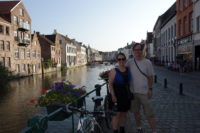 Yesterday was not a day of near-misses and wrong directions. It was a scouting day! We fit in a long and successful day of touring today, from about 9:00 am to about 10:30 pm. We have seen Ghent. Phew.
Yesterday was not a day of near-misses and wrong directions. It was a scouting day! We fit in a long and successful day of touring today, from about 9:00 am to about 10:30 pm. We have seen Ghent. Phew.
We started by catching the correct bus heading east out of the city center, and then walking a mile or so to our destination – the Groot Begijnhof. Insert your “I am Groot” joke here. Begijnhofs were Belgian and near-Belgium institutions where widowed and single women could go to live in community, but without taking full convent orders. They vowed obedience and chastity, but then were allowed to work and live by themselves in the community. Ghent had three of these places in the city, and the Groot Begijnhof was the largest and newest of them, being completed in the 1870s.
I had no idea a place like this existed, and it was all very peaceful with harmonious brick buildings. We wandered around the walled-in compound, which is based around a huge church (which was sadly closed to the public). The current-day community is made up of anyone who buys a ninety-nine-year lease on a home, but it is still really quiet. Owners are not allowed to change much of anything, since it is a World Heritage Site. It is made up of about eighty homes, the church, and a few other buildings, all enclosed in a brick wall. They even had three cows grazing in a field behind the church, and this on the edge of a city of 250,000 people.
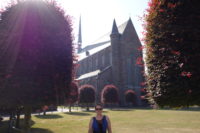 Back in town, we took our one-day-delayed boat ride, which was free on our Ghent City Card. We have really made out on those cards, spending seventy euros to get into over one hundred euros’ worth of attractions, not including multiple trips on the trams and buses. The boat trip was about forty minutes long, and took us along the main strip of the old river harbor, turning at the main bridge (St. Michael’s Bridge), before heading all the way up an old canal to where it now terminates at a road. We had commentary provided by the boat’s captain, who spoke in English, French, and German. He was a little hard to understand over the PA system, but that is often the case with PA systems. He told us about some of the buildings in town and a little history, but the real enjoyment was in seeing the town from the perspective of the river and canal.
Back in town, we took our one-day-delayed boat ride, which was free on our Ghent City Card. We have really made out on those cards, spending seventy euros to get into over one hundred euros’ worth of attractions, not including multiple trips on the trams and buses. The boat trip was about forty minutes long, and took us along the main strip of the old river harbor, turning at the main bridge (St. Michael’s Bridge), before heading all the way up an old canal to where it now terminates at a road. We had commentary provided by the boat’s captain, who spoke in English, French, and German. He was a little hard to understand over the PA system, but that is often the case with PA systems. He told us about some of the buildings in town and a little history, but the real enjoyment was in seeing the town from the perspective of the river and canal.
Having crossed off yesterday’s events by noon today, we hopped on a tram heading northwest out of the city, getting off at the Dr. Guislain Museum, a museum in a former psychiatric institution, dedicated to the history of the treatment of the mentally ill, with a focus on Dr. Guislain, who revolutionized the treatment of the mentally ill in the 1800s, and right here in Ghent. The museum also house three art collections – one by trained artists who spent time in mental institutions talking to patients, one by self-trained artists, and one by patients themselves.
The history part of the museum was both fascinating and sad. It covered the treatment of the mad from medieval times when they would bore holes in the head to release the bad spirits, up to today with medication and MRI machines. In between, the treatment of the ill took various steps, but really took a leap with Dr. Guislain’s reforms in the 1850s, when he treated the mentally ill as ill and treatable. He built open and safe spaces for the patients, required good food to be served, and required staff to treat the patients with respect, including requiring them not to gossip about patients outside the institution. He helped write laws on mental health that were in effect until 1991. Dr, Guislain teamed with the religious orders of the Catholic Church because he thought the religious men helped calm the patients, and they were a much cheaper way to staff the hospital, when compared to secular nurses and caregivers.
The art exhibits from the patients were interesting, and several were excellent. There was a painter of still life works that focused on everyday objects like irons and phones that Mer and I both liked very much. The works from the trained artists were usually thought-provoking, although some were obscure or pretentious. The works of the untrained artists were across the board, with some being childlike to some being very advanced. It was not clear to me how many artists were ill and how many were not, and I think that was the point – that the art stands apart from the mental health state of the artist; the ill can and do produce good art.
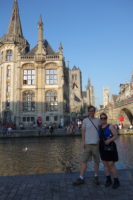 That got us back into town around 4:00, looking for supper in a culture that usually starts to think about supper around 8:00. We eventually found a restaurant that was open and serving on the large square where we ate French fries a couple of days ago. We passed a very pleasant hour eating and people=watching.
That got us back into town around 4:00, looking for supper in a culture that usually starts to think about supper around 8:00. We eventually found a restaurant that was open and serving on the large square where we ate French fries a couple of days ago. We passed a very pleasant hour eating and people=watching.
Mer had a plan for us to do something right at 7:00, so we went back to the room to rest up for about thirty minutes. We walked over to the tourist information office across from the castle, but it was closed. We hung out outside the door until Mieke (“mee-ka”) walked up and introduced herself. She is the mother of four and grandmother of six, lives on a houseboat on the town’s bigger river (the Scheldt), is from Ghent, spent a year abroad in California, and happens to be a tour guide. She was there to take us on a private three-hour tour of Ghent.
Mieke took us all around old Ghent, starting at the castle. We walked down old medieval lanes that we had not yet seen, and which now make up a trendy neighborhood near the castle. She showed us what used to be a monastery where the monks healed people, and then round again to the River Leie harbor area, where she told us about how the shipping guilds used to fleece money from traders by requiring them to transfer the cargo to Ghent ships for a half-mile section of river, pay a toll, sell twenty-five percent of the cargo at Ghent rates, and then pay to transfer the cargo back to the original ships. It made Ghent really wealthy, along with the money that came pouring in from the cloth trade, first from wool and then later from cotton.
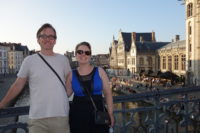 We crossed St, Michael’s Bridge and heard about the two major churches in the old town and the bell tower, which was deliberately built to be taller than the church steeples. She told us that the people of Ghent hated the new covered square space in front of city hall because they thought it looked like a sheep barn, but they have come around to liking it. We hiked out to the Scheldt River, and Mieke took us to an old ruined abbey. She is a volunteer at the abbey once a week to tell people about it, so she had a key, so we got to wander the abbey grounds by ourselves. It is much in ruin because most of the stone was carried away by the Spanish in the 1500s to build a fort nearby, but the old church still stands and is very impressive. It is still used for concerts, and has the tombstone of the older of the Van Eyck brothers (the painters of Ghent’s famous altarpiece) housed there.
We crossed St, Michael’s Bridge and heard about the two major churches in the old town and the bell tower, which was deliberately built to be taller than the church steeples. She told us that the people of Ghent hated the new covered square space in front of city hall because they thought it looked like a sheep barn, but they have come around to liking it. We hiked out to the Scheldt River, and Mieke took us to an old ruined abbey. She is a volunteer at the abbey once a week to tell people about it, so she had a key, so we got to wander the abbey grounds by ourselves. It is much in ruin because most of the stone was carried away by the Spanish in the 1500s to build a fort nearby, but the old church still stands and is very impressive. It is still used for concerts, and has the tombstone of the older of the Van Eyck brothers (the painters of Ghent’s famous altarpiece) housed there.
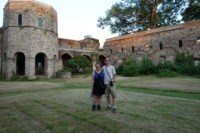 Mieke took us back into town, showing us a trendy food court that is housed in what used to be a large church, and dropped us off in the same square where we had eaten supper. Mer and I love local guides, and the evening had been informative and gotten us to several new-to-us places.
Mieke took us back into town, showing us a trendy food court that is housed in what used to be a large church, and dropped us off in the same square where we had eaten supper. Mer and I love local guides, and the evening had been informative and gotten us to several new-to-us places.
Long day, but worth it. We feel as if we have a pretty good sense of Ghent, and since the festival season starts this coming weekend, we feel pretty good about getting out of town. We head out for Bruges via Flanders Fields tomorrow.
Begijnhasselhof. There. No Groot joke.